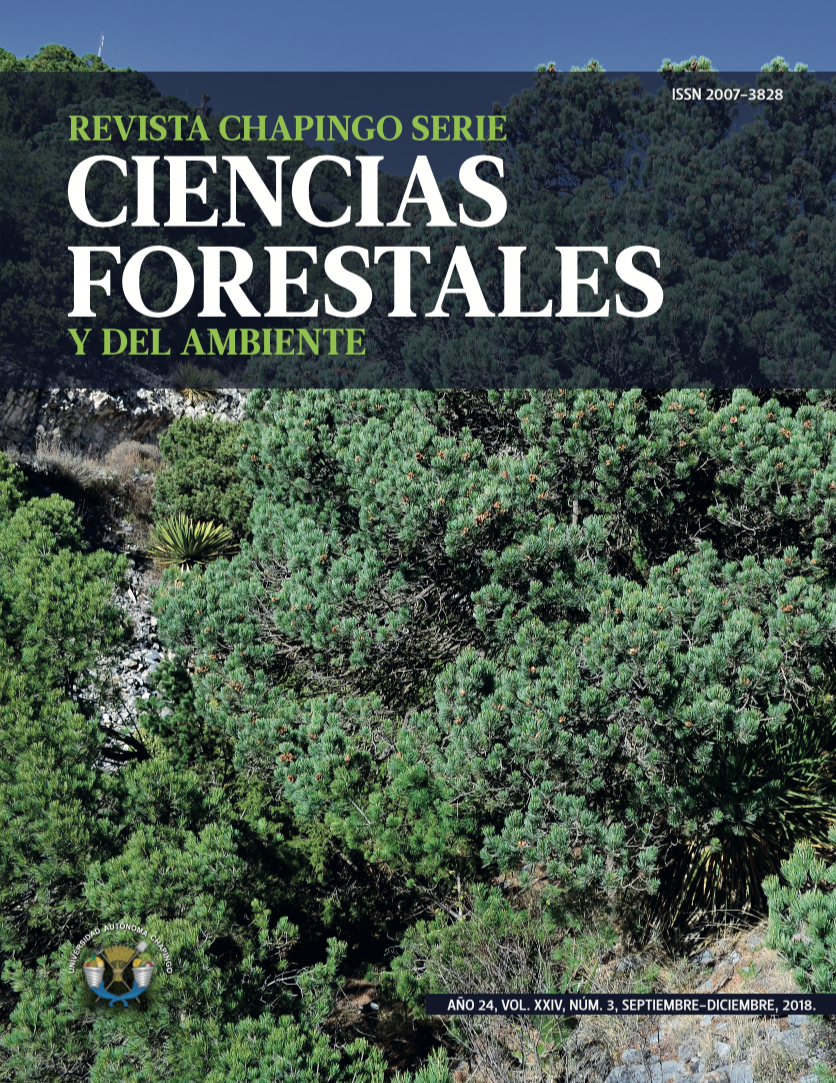##article.highlights##
- A través de siete técnicas se definieron 13 valores de ancho de banda (h).
- Hubo gran variación en los valores obtenidos de h (entre 2 550 y 41 906 m).
- El valor de h estadísticamente más adecuado se definió entre 5 300 y 5 900 m.
- El valor de h más cercano al rango óptimo se obtuvo con la técnica distancia aleatoria media (5 395 m).
- Es posible seleccionar h bajo criterios estadísticos, evitando el uso de criterios subjetivos.
Resumen
Introducción: La cartografía de áreas con mayor densidad de incendios forestales puede desarrollarse a través de la estimación de densidad kernel, la cual requiere la selección de una función y un ancho de banda (h). El valor h, cuando se define mediante procesos subjetivos (visuales), dependerá del conocimiento y experiencia del seleccionador.
Objetivo: Proponer una alternativa estadística, basada en información de incendios forestales (2005-2013) del estado de Jalisco, México, para la selección de h como soporte en la estimación de la densidad kernel.
Materiales y métodos: A través de siete técnicas se definieron 13 valores de h. El valor de h se seleccionó usando los estadísticos siguientes: raíz del error cuadrático medio, raíz del error medio cuadrático integrado, coeficiente de variación y porcentaje comparativo.
Resultados y discusión: Los valores h obtenidos con las técnicas probadas se encontraron entre 2 550 y 41 906 m. Hubo gran variación en los resultados; el rango entre el valor máximo y el mínimo fue 39 356.34 m con una media de 10 936.74 ± 9 955.04 m. Lo anterior implica que no existe un proceso único y universal para todos los casos. De acuerdo con los criterios de validación, el valor de h estadísticamente más adecuado se encuentra entre 5 300 y 5 900 m; el resultado más cercano se obtuvo con la técnica distancia aleatoria media (5 395 m).
Conclusión: Es posible seleccionar h bajo una perspectiva estadística práctica, evitando el uso de criterios subjetivos.
Citas
Álvarez, E., & Yohai, V. (2012). M-estimators for isotonic regression. Journal of Statistical Planning and Inference, 142(8), 2351–2368. doi: https://doi.org/10.1016/j.jspi.2012.02.051
Amatulli, G., Perez-Cabello, F., & de la Riva, J. (2007). Mapping lighting/human caused wildfires occurrence under ignition point location uncertainty. Ecological Modelling, 200(3-4), 321–333. doi: https://doi.org/10.1016/j.ecolmodel.2006.08.001
Anselin, L., Bera, A. K., Florax, R., & Yoon, M. J. (1996). Simple diagnostic tests for spatial dependence. Regional Science and Urban Economics, 26(1), 77–104. doi: https://doi.org/10.1016/0166-0462(95)02111-6
Comisión Nacional Forestal (CONAFOR). (2015). Incendios. Retrieved August 4, 2015 from http://www.conafor.gob.mx/web/temas-forestales/incendios/
de la Riva, J., Pérez, C. F., Lana, R. N., & Koutsias, N. (2004). Mapping wildfire occurrence at regional scale. Remote Sensing of Environment, 92(3), 363–369. doi: https://doi.org/10.1016/j.rse.2004.06.022.
de Smith, M. J., Goodchild, M. F., & Longley, P. A. (2009). Geospatial analysis. A comprehensive guide to principles, Techniques and software tools (3rd ed.). Winchelsea, UK: The Winchelsea Press. Retrieved from http://www.spatial analysisonline.com/
Fuenzalida, M., Cobs, V., & Guerrero, R. (2013). El territorio como unidad de análisis en estudios sobre las determinantes sociales de la salud. Argos, 30(59), 87–106. Retrieved from http://www.academia.edu/27985206/El_territorio_como_unidad_de_an %C3%A1lisis_en_estudios_sobre_las_determinantes_sociales_de_la_salud
Koutsias, N., Kalabokidis, K., & Allgöwer, B. (2004). Fire occurrence patterns at landscape level: Beyond positional accuracy of ignition points with kernel density estimation methods. Natural Resource Modeling, 17(4), 359–375. doi: https://doi.org/10.1111/j.1939-7445.2004.tb00141.x
Krisp, J. M., Peters, S., Murphy, C. E., & Fan, H. (2009). Visual bandwidth selection for kernel density maps. PFG–Journal of Photogrammetry, Remote Sensing and Geoinformation Science, 5, 445–454. doi: https://doi.org/10.1127/1432-8364/2009/0032
Kulldorff, M., & Nagarwalla, N. (1995). Spatial disease clusters: Detection and inference. Statistics in Medicine, 14(8), 799–810. doi: https://doi.org/10.1002/sim. 4780140809
Kuter, S., Usul, N., & Kuter, N. (2011). Bandwidth determination for kernel density analysis of wildfire events at forest sub-district scale. Ecological Modelling, 222(17), 3033–3040. doi: https://doi.org/10.1016/j.ecolmodel.2011.06.006
Mohammadi, F., Bavaghar, M. R., & Shabanian, N. (2014). Forest fire risk zone modeling using logistic regression and GIS: an Iranian case study. Small-scale Forestry, 13(1), 117–125. doi: https://doi.org/10.1007/s11842-013-9244-4
Salvati, L., & Ferrara, A. (2015). Validation of MEDALUS fire risk index using forest fire statistics through a multivariate approach. Ecological Indicators, 48, 365–369. doi: https://doi.org/10.1016/j.ecolind.2014.08.027
Seaman, D. E., & Powell, R. A. (1996). An evaluation of the accuracy of kernel density estimators for home range analysis. Ecology, 77(7), 2075–2085. Retrieved from http://links.jstor.org/sici?sici=0012-9658%28199610%2977%3A7%3C2075%3AAEOTAO%3E2.0.CO%3B2-%23
Silverman, B. W. (1986). Density estimation for statistics and data analysis. London, UK: Chapman & Hall/CRC. Retrieved fromhttps://ned.ipac.caltech.edu/ level5/March02/Silverman/paper.pdf
Thompson, M. P., Calkin, D. E., Finney, M. A., Gebert, K. M., & Hand, M. S. (2013). A risk-based approach to wildland fire budgetary planning. Forest Science, 59(1), 63–77. doi: https://doi.org/10.5849/forsci.09-124.
Turlach, B. A. (1999). Bandwidth selection in kernel density estimation: A review. Belgium: Institut de Statistique Université Catholique de Louvain. Retrieved from http://citeseerx.ist.psu.edu/viewdoc/download?doi=10.1.1.44.6770&rep=rep1&type=pdf
Vilar, H. L., Martín, I. M. P., & Martínez, V. F. J. (2011). Logistic regression models for human-caused wildfire risk estimation: analysing the effect of the spatial accuracy in fire occurrence data. European Journal of Forest Research, 130(6), 983–996. doi: https://doi.org/10.1007/s10342-011-0488-2
Vrahimis, A. (2010). Smoothing methodology with applications to nonparametric statistics. Tesis Doctoral, University of Manchester. Retrieved from https://www.research.manchester.ac.uk/portal/files/54503714/FULL_TEXT

Esta obra está bajo una licencia internacional Creative Commons Atribución-NoComercial 4.0.
Derechos de autor 2018 Revista Chapingo Serie Ciencias Forestales y del Ambiente



